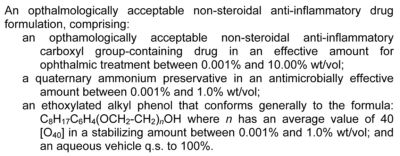Read a Patent Claim?
Read This One

How do you read a patent claim? Does this one make any sense to you?
Many people picking up a patent to read a patent claim would think it was gibberish. Partly because the technology is something they do not understand - partly because they are not aware of how claims are constructed.
Well - I will plainly admit I know very little about "opthmologically acceptable non-steroidal anti-inflammatory drug formulations". Whew.
But if you know how all claims are structured you can start to see what it might mean. So let's analyze it and after you understand it you can probably read any claim.
The Structure of All Claims
Here is how to read a claim - any claim. It has a structure of:
A preamble
A transition phrase
A list of elements
In this case the preamble is:
An opthmologically acceptable non-steroidal anti-inflammatory drug formulation
The transition phrase is:
comprising
Element 1 is:
(a) an ophthalmologically acceptable non-steroidal anti-inflammatory carboxyl group-containing drug in an effective amount for ophthalmic treatment between 0.001% and 10.0% wt/vol;
Element 2 is:
(b) a quaternary ammonium preservative in an antimicrobially effective amount between 0.001% and 1.0% wt/vol;
and Element 3 is:
(c) an ethoxylated alkyl phenol that conforms generally to the formula: C8 H17 C6 H4 (OCH2 CH2)n OH where n has an average value of 40 in a stabilizing amount between 0.001% and 1.0% wt/vol; and an aqueous vehicle q.s. to 100%.
Explanation
The preamble describes the field of the invention. The transition phrase "comprising" is found on the great majority of patents. Think of it's meaning as "including at least". Thus the invention may include many things but it includes at least the following things - and those things are the three elements (a), (b), and (c).
So this particular patent claim contains a least these 3 elements - an invention can have many other things but if does not have these 3 it is not covered by this claim.
This leads to a concept in patent infringement law. It is called the all elements rule. If anyone tries to practice in this field - they will only infringe this claim if they practice each and every one of the three elements. If they do not practice element 2 as it is written then they are not infringing.
A Note of Warning
The above explanation is a very big simplification of claim structure. It is meant to help you to read a patent claim. And it is true - examiners expect claims to be structured this way and patent agents and attorneys write them this way. So you should now be able to apply these simple principles in reading any patent.
But if you are facing a business situation in which you are concerned about the possibility of infringing a claim - get a specialist to analyze it for you. And not just the one patent you have found. A through search must be done for any patent that might have dangerous claims. Investing a little money in a freedom to operate analysis is a small insurance policy.
Links
Read a Patent Claim
Return to the Top of This Page
The Business of Patents Home Page
Return to Home Page
Patent Law
Return to the Patent Law Page.
Mike Ervin
Mike Ervin - Cost Effective Small Business Patent Protection.
Contact Me
If you have any questions on on this site - please feel free to contact me.